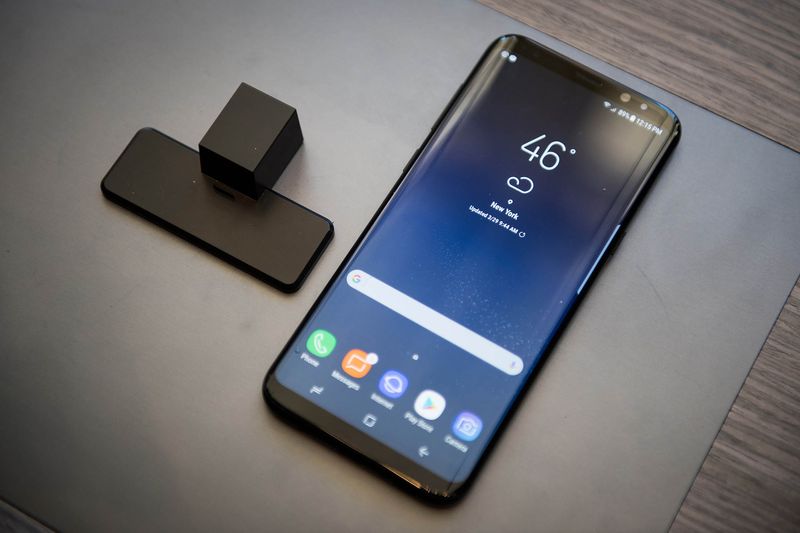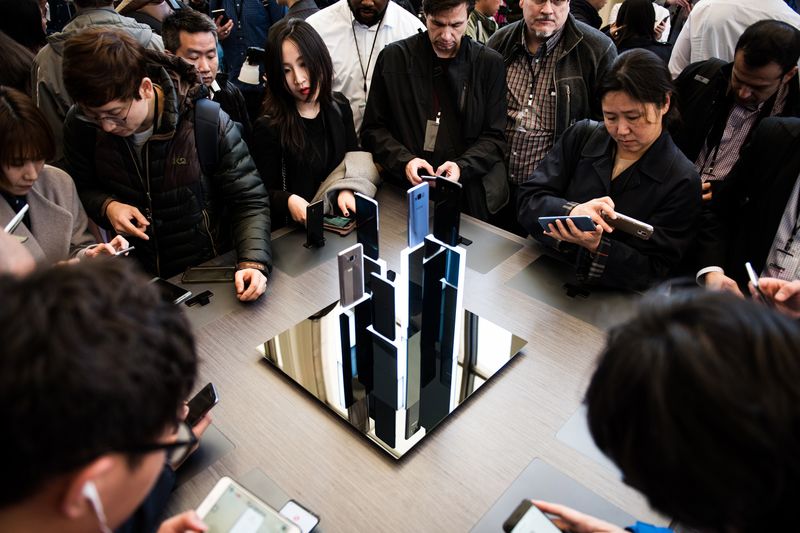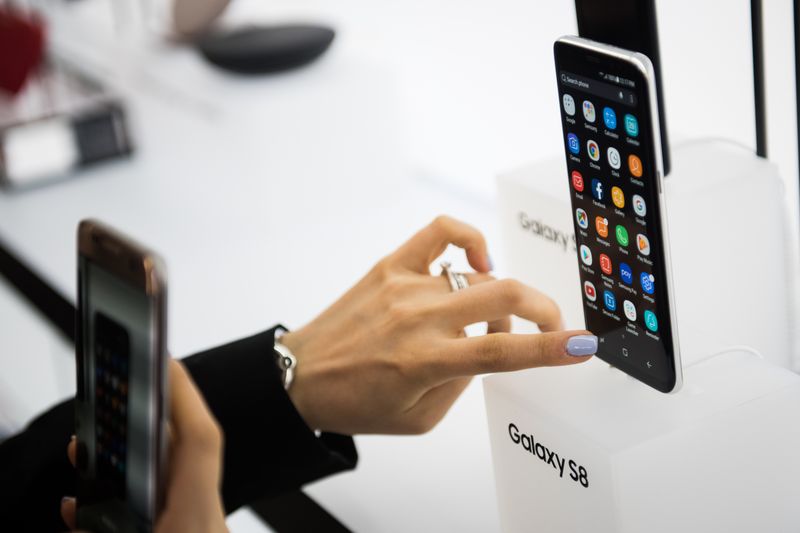Samsung Electronics Co. knows it needs to get its new flagship smartphone right. Apart from making sure the gadget won’t cause bodily harm, the company packed it with a plethora of new features: taller, curved screens, encrypted facial recognition, deeper display colors, system-wide voice control and the ability to turn into a desktop computer.
The Galaxy S8 comes in two sizes, a standard 5.8-inch display model and a Plus version with a 6.2-inch screen. Both are larger than the iPhone 7 and iPhone 7 Plus, the lineup’s main competition until Apple Inc. rolls out its 10th-anniversary iPhone later this year. In line with smartphone trends, Samsung’s new devices feature slimmer bezels alongside the display and are curved on all four corners. Pre-orders will begin soon after the unveiling, ahead of the S8’s April 21 release. It comes in five colors: midnight black, maple gold, coral blue, arctic silver and orchid gray.

Photographer: Mark Kauzlarich/Bloomberg
The S8 represents Samsung’s biggest prospect for a turnaround after the Note 7 debacle last year. The bigger-sized smartphone debuted to positive reviews, only to be killed off after some units showed a tendency to catch fire and explode, forcing the South Korean manufacturer to yank the product off shelves. The crisis cost the company more than $6 billion and its global lead in smartphone sales. Samsung accounted for 17.8 percent of global smartphone sales in the last three months of 2016, slightly less than Apple, according to Gartner. While Samsung may be targeting Apple, it also faces challenges from up-and-coming rivals such as Huawei Technologies Co. and Oppo, especially in China, the world’s biggest smartphone market.
“We must not only win back customers’ trust, but also the high expectations that they have always held for Samsung,” said Lee Young-hee, executive vice president of Samsung’s mobile business. “We have put our utmost effort to provide customers with near-perfect devices to earn back their trust.”
Also casting a shadow over the S8’s debut is the trial of Jay Y. Lee, the Samsung group’s heir apparent and de facto chief, who was arrested on bribery and embezzlement charges stemming from a national influence-peddling scandal. He has denied any wrongdoing. Still, even with the Note 7 imbroglio and legal troubles, Samsung shares have been trading near record highs, thanks to a robust semiconductor business. The stock rose as much as 1.6 percent in Seoul trading after the phone was unveiled.

Photographer: Mark Kauzlarich/Bloomberg
Unveiling the S8 Wednesday at New York’s Lincoln Center, Samsung’s president of mobile communications, DJ Koh, highlighted innovation and how the company had learned from its mistakes. Executives describing the phone focused mostly on its aesthetics, and went through the specs fairly quickly, a strategy probably meant to avoid “discussing things like the battery, which could remind people of their troubles,” said Simon Blanchard, assistant professor of marketing at Georgetown University’s McDonough School of Business.
The S8’s design features and new and improved cameras should be enough to entice consumers to go see it in a store and then potentially make a purchase, Blanchard said. “They might have in the back of their mind that Samsung phones had issues, but they might say, `This is a phone that looks pretty,’ so they’ll go see it,” he said.

Photographer: Mark Kauzlarich/Bloomberg
KB Securities Co. expects Samsung to ship about 46 million S8 handsets and the mobile business to post a 67 percent rise in operating profit to 3.5 trillion won ($3.1 billion) in the second quarter on the back of the new devices.
Samsung’s corporate logo is now gone from the front of the device, making room for a taller, 18.5:9 ratio screen, which the company is calling the Infinity Display. The new dimensions mean the thin black bars that typically surround widescreen videos can be eliminated, making them look bigger when played. The home button, with vibrating feedback, is integrated into the bottom of the screen. On the software side, users can now clip specific apps to the top of the screen so that, for instance, they can compose emails while reading a web page.
The S8 will also feature a digital assistant that studies its owner’s activities to offer helpful tips and information, seeking to challenge Apple’s Siri and Amazon.com Inc.’s Alexa. Called Bixby, Samsung’s service can be activated via the phone’s side button. The system has a few parts: one is a standard, Siri-like voice control view, another is a list view of upcoming calendar appointments and reminders. The feature is also integrated with the camera so that it can identify objects like buildings, or a particular bottle of wine. Users can operate many of the phone’s functions via voice instead of the touchscreen.
While some previous Galaxy models let users unlock their device using a facial scanner, the S8 is the first Samsung phone to encrypt facial data. Combined with iris and fingerprint scanning, that can be used to offer more security for mobile banking and other sensitive applications.
Another new trick: the new Samsung phones can essentially become a full-blown desktop computer via a separately sold docking station called the DeX (an idea introduced by Motorola in 2011). The phone will add upgraded front and rear cameras, and continue to include wireless charging. The camera app will include built-in Snapchat-like stickers that can be placed over images.
Unsurprisingly, Samsung is touting the safety of the S8’s battery, given that the cause of the Note 7 fires was due to faulty battery design. A Samsung television commercial released earlier this year shows engineers testing batteries by drilling a hole and apparently heating them in what the company called an “eight-point battery safety check.” The company says the standard S8 model has a 3,000 mAh battery while the Plus version has a capacity of 3,500 mAh.
“Success isn’t going to come overnight for the S8 and it’ll be a while before consumers feel confident the phone has no problems like the Note 7,” said Koo Chang-hwan, who researches corporate brands at Seoul-based Korea Reputation Center. “The biggest issue hobbling the company is still the trial of its de facto chief. That will overshadow the S8 and a single product may not be enough to put the risk surrounding the top executive behind.”

